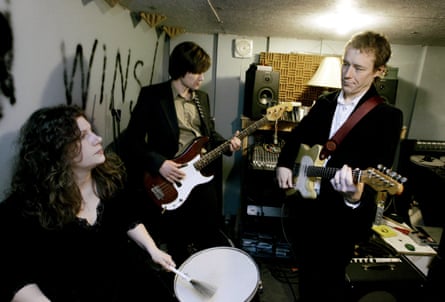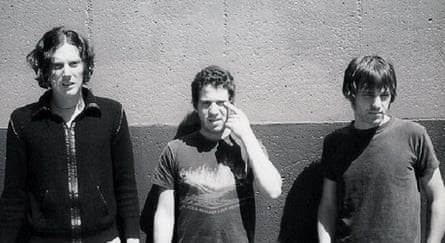‘We were not trying to make people dance, we were not trying to ‘rock’ – we were trying to make things that were beautiful,” says Dean Wareham, who formed Galaxie 500 in Boston in 1987 with Naomi Yang and Damon Krukowski. Their music, Wareham explains, was “slower, more introspective” than most underground rock in America during the late 80s, a scene defined by distortion, volume and velocity, dominated by hardcore punks, proto-grungers and the nihilistic fans of the caustic subgenre entitled pigfuck. To stand apart was to invite pushback: Wareham recalls one pigfuck aficionado giving the band the finger and screaming “Faggot!” throughout their first Chicago gig until he was ejected.
But Galaxie 500 held their nerve. Tracks like 1988 debut single Tugboat are masterpieces of longing, and won a cult following on both sides of the Atlantic before internal frictions ran the band aground in 1991. “After working in a somewhat restrictive format, it was time to try something else,” says Wareham (who went on to form urbane indie-rockers Luna).
But as the 90s dawned, a wave of musicians across America recognised limitless potential within that restrictive format. This movement drew power from restraint, from dialling down amps, slowing tempos and paring music back to its elements, recognising Galaxie 500 – alongside kindred contemporaries American Music Club and Red House Painters – as pivotal pioneers.
Journalists dubbed this genre “slowcore”, much to the musicians’ chagrin. “It was an insult,” says Bedhead’s Matt Kadane. “We never saw slowness as the essence of what we were doing.” But the term has endured and while few slowcore bands graduated beyond cult stardom, the likes of Codeine and Duster have attracted considerable new audiences – gen Z-ers who, in an era of such information overload, find these artists’ stark power and sense of space more impactful than ever.
Perhaps the most extreme of the slowcore bands was Codeine, formed in New York in 1989 by bassist/singer Stephen Immerwahr, guitarist John Engle and drummer Chris Brokaw – their classic albums are being reissued this month and they’re back out on tour.
Codeine played slow; Brokaw once said he could “play a snare hit, go get a drink and be back at the drumkit before the next beat”. They shared their feel for space and tension with Slint, then laying the quiet/loud foundations of post-rock over in Louisville, Kentucky – but Codeine had little interest in the loud part. “Our music didn’t build and then bust out,” says Brokaw. “We were almost anti-catharsis. There was austerity to what we were doing, a delicacy.”
Codeine’s deliberate pace suited songs freighted with Immerwahr’s angst. “My emotional state, my disassociation from others, was the core of it,” he admits. But this music was emotional without the histrionics of grunge. “It was a reaction to that Eddie Vedder style of singing. What suited these songs, my own lived experience, was something smaller, something anti-epic.” Possessed of a simmering power, their 1990 debut album Frigid Stars LP was championed in the UK by John Peel. That’s how Stuart Braithwaite of Mogwai first heard them as a teenager. “I responded to the minimalism, the raw sadness of the music,” says Braithwaite. “I’d grown up on the Cure so already had a penchant for uncheery music. Codeine took that to the next level. You weren’t going to play Frigid Stars LP at parties, but it was beautiful: the lyrics bare and honest, the musicality sparing.”
Like Codeine, the music of Bedhead, from Dallas, Texas, was similarly rooted in the pain of its songwriters. “So much of our music was an outpouring of grief,” says singer/guitarist Matt Kadane, who formed the group with brother Bubba following their father’s death from a brain tumour. “It was a drawn-out disease – the anatomy of death unfolded at glacial pace,” Kadane says. “Bubba and I didn’t talk much about it. But we played music together.”
They drew inspiration from the starkly experimental final albums of UK group Talk Talk. “The Colour of Spring had stripped a lot away, but Spirit of Eden just floored us,” Kadane says. “They’d got down to the essentials. So we started breaking things down, exorcising these nasty qualities coming from grunge and everything that was commercialised.” Like Codeine, Kadane recoiled from the bombast of big rock. “I wanted – needed – to say things one could easily feel embarrassed about, and the countervailing mechanism was restraint. Our songs sounded better slow and stripped down, when we tried to say more with less.”
The third key group of slowcore’s golden era, Low hailed from Duluth, Minnesota. Inspired by Galaxie 500, singer/guitarist Alan Sparhawk sent [producer and Shimmy-Disc records founder] Kramer demos he’d recorded with wife Mimi Parker, who accompanied on a minimal drum kit. Parker’s spectral vocals, however, were Low’s secret weapon. “Mimi’s harmonies were like putting a spirit into a body,” Sparhawk told me in 2013. “Like taking something two-dimensional, and making it three-dimensional.”
From their very earliest recordings – with Kramer applying his trademark reverb to the group’s minimal haunting and ghostly vocals – Low were remarkable, sombre, their songs impossibly beautiful, and quietly heavy. Their narcotic glide through Little Drummer Boy soundtracked Gap’s 2000 Christmas advertising campaign, the dreamy clip (fittingly titled “Slow Down”) bringing them an unlikely mainstream audience. Sparhawk was sanguine over the slowcore tag, telling the Dallas Observer in 2001 he was “fine with being the slow, quiet band”. But Low would ultimately transcend that paradigm across a series of increasingly adventurous albums that experimented with volume and viscera, before Parker’s death last year ended the group.

Such longevity eluded Codeine and Bedhead. The seriousness with which Codeine approached their music was gruelling. “I remember one night we played and I felt like we’d failed,” Brokaw says. “I threw garbage cans across Avenue A and smashed bottles – a complete fucking shitfit in the street.” Their studio experiences were no less tense. A first swing at their second album was scrapped, finally seeing release 30 years later in 2022 as Dessau; it might be Codeine’s finest work. “My standards were maybe inhuman,” Immerwahr admits, of shelving the sessions. “I was wound really tight. There were weird high-pitch frequencies on the vocal tracks that [producer Mike McMackin] couldn’t hear but I definitely could. It sounds like I was losing my mind. But I’m convinced they were there.”
Codeine finally completed their second album, the stark, brilliant The White Birch, in 1994. Brokaw had already exited two years earlier, replaced by Doug Scharin. After Codeine split later that year, Immerwahr quit music. “The muse comes and the muse goes,” he reasons today. “My songwriting had ground to a halt. Ending Codeine was worse than any break-up. I probably could have benefited from medication, and more compassion for myself.”
after newsletter promotion
The sessions for Bedhead’s three incandescent albums were scarcely less intense or luck-starved than Codeine’s (the master tapes for their “cursed” second album, Beheaded, were even stolen from Bubba’s car). Kadane split the group in 1998 to pursue a PhD, forming the New Year with Bubba and Chris Brokaw a year later. Bedhead’s final track, The Present, was also their greatest, a haunted-ballroom slow-dance swansong that closed with the declaration: “I’d rather be a relic / Than part of the present.” “That’s how I honestly felt,” says Kadane, of Bedhead’s final words. “At our most hubristic and obnoxious, we wanted to be timeless. That meant not being part of everything happening in the present.”
As the 90s wore on, slowcore’s spartan aesthetic evolved. The genre grew to encompass the blue lullabies of Spain; the hypnotic intimacy of the For Carnation, led by Slint’s Brian McMahan; the whispered confessions of early Cat Power. Jim Putnam wove together traditional Hawaiian folk, Brazilian bossa nova and the dreamy haze of Pink Floyd to concoct the sublime melancholia of Radar Bros’s self-titled debut; “I lean towards the sad and the beautiful,” he says.

New York’s Rex, which united Codeine drummer Doug Scharin with Curtis Harvey and Phil Spirito, paired the artful spareness of slowcore with Harvey’s passion for Appalachian folk, “these seriously sad songs where someone always gets bit by a snake and dies”, he explains. On their second album, C, Rex were drawn into the orbit of Chicago’s post-rock scene, collaborating with members of Tortoise and Red Red Meat, and adding strings and hypnotic polyrhythmic percussion to their parched Americana. Many of these artists still resisted the “slowcore” tag, of course. “We flew Everett True of Melody Maker to California to interview us,” remembers Radar Brother Putnam. “We kept telling him, ‘We’re not slowcore’. He wrote a beautiful feature, but then we noticed the first letter of each paragraph spelled out ‘slowcore’. We thought that was hilarious.”
Three decades on, the genre’s influence is subtle but pervasive, detectible in the dolorous Lana Del Rey, the bare-boned glide of Daughter’s recent single Party, in the whispered dramas of modern day slowcore scions like Bad Sav, Haress and the Coral Sea. Codeine, meanwhile, have finally enjoyed an unexpected breakthrough, finding a new audience after their cover of Joy Division’s Atmosphere soundtracked Netflix thriller 13 Reasons Why. “It’s very powerful music, and very important to me,” says Brokaw. “We first reunited for a handful of shows a decade ago, and getting inside these songs again and then having it stop again was harder than I could have imagined. I’m better prepared for it this time.”
Dean Wareham, meanwhile, returned to that “restrictive format” in 2010, when he and wife Britta Phillips were co-commissioned by the Andy Warhol Museum to soundtrack Warhol’s legendary screen-tests of Factory stars. The experience reacquainted Wareham with the creative advantages of taking things slowly. “Andy filmed them at a faster speed than he projected them,” he says. “And so many more emotions flash across the human face when you slow it down. You realise there’s so much more going on.” Is there a parallel between Warhol’s hypnotic, slowed-down films of beautiful people, and the slow, beautiful music Wareham made in Galaxie 500? “Andy was not afraid to bore people,” Wareham grins. “And we were not afraid to push it that way a little, too.”

